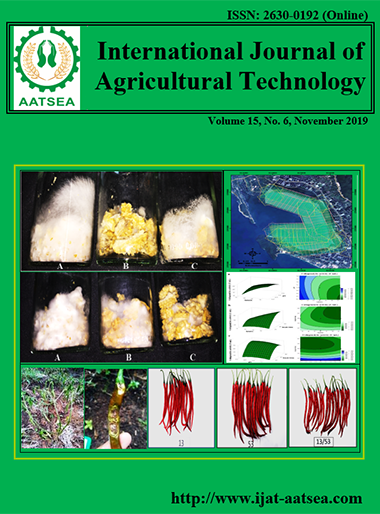GC-MS analysis and biopesticide properties of different crude extracts of Annona squamosa and Annona muricata
Main Article Content
Abstract
Most common compounds identified by GC-MS analysis of ethanolic extracts from leaves of Annona squamosa (sweetsop) and Annona muricata (soursop) were neophytadiene, hexadecanoic acid, and trans-caryophyllene. Hexadecenoic acid and ethyl oleate were identified in seeds of A. muricata, while only methyl-p-tert-butyl phenylacetate was identified in seeds extract of A. squamosa. Crude extracts were tested for their antifungal activities against postharvest plant pathogens, insecticidal activities against brown planthopper, Nilaparvata lugens (Stål) and cassava mealybug, Phenacoccus manihoti Matile-Ferrero. Results showed low inhibitory effect (less than 20%) for the pathogenic fungi insecticidal test against cassava mealybug of all crude brown planthopper treated with 5% seed extract of A. squamosa, indicating its potential as an alternative botanical insecticide. Further studies are required to improve yield and extract quality.
Article Details

This work is licensed under a Creative Commons Attribution-NonCommercial-NoDerivatives 4.0 International License.
References
Astani, A., Reichling, J. and Schnitzler, P. (2011). Screening for antiviral activities of isolated compounds from essential oils. Evidence-Based Complementary and Alternative Medicine Doi:10.1093/ecam/nep187.
Begum, N., Sharma, B. and Pandey, R. S. (2010). Toxicity potential and AchE activity of some plant extracts in Musca domestica. Journal of Biofertilizers and Biopesticides, 2:108-114.
Begum, N., Sharma, B. and Pandey, R. S. (2011). Insecticidal potential of Calotropis procera and Annona squamosa ethanol extracts against Musca domestica. Natural Products: An Indian Journal, 7:279-286.
Chavan, M. J., Wakte, P. S. and Shinde, D. B. (2010). Analgesic and anti-inflammatory activity of caryophyllene oxide from Annona squamosa L. bark. Phytomedicine, 17:149-151.
de Paula, J. P., Gomes-Carneiro, M. R. and Paumgartten, F. J. R. (2003). Chemical composition, toxicity and mosquito repellency of Ocimum selloi oil. Journal of Ethnopharmacology, 88:253-260.
Dhembare, A. J., Deokar, M. and Kolte, P. (2011). Efficacy of some plant extracts against rose aphid Macrosiphum rosaeformes (Davis). Journal of Experimental Zoology, 14: 325-327.
Ghasemzadeh, A. and Jaafar, H. Z. (2011). Effects of solvent type on phenolics and flavonoids content and antioxidant activities in two varieties of young ginger (Zingiber officinale Roscoe) extracts. Journal of Medicinal Plant Research, 5:1147-1154.
Harivelo, L., Ravaomanarivo, R., Razafindraleva, H. A., Raharimalala, F. N., Rasoahantaveloniaina, B., Hervé Ravelonandro, P. and Mavingui, P. (2014). Efficacy of seed extracts of Annona squamosa and Annona muricata (Annonaceae) for the control of Aedes albopictus and Culex quinquefasciatus (Culicidae). Asian Pacific Journal of Tropical Biomedicine. Asian Pacific Journal of Tropical Biomedicine, 4:787-795.
Isman, M. B. (2006). Botanical insecticides, deterrents, and repellents in modern agriculture and an increasingly regulated world. Annual Review of Entomology, 51:45-66.
Kamaraj, C., Bagavan, A., Elango, G., Zahir, A. A., Rajakumar, G., Marimuthu, S., Santhoshkumar, T. and Rahuman, A. A. (2011). Larvicidal activity of medicinal plant extracts against Anopheles subpictus and Culex tritaeniorhynchus. Indian Journal of Medical Research, 134:101-106.
Konkala, A., Sabita, R. S. and Kaur, A. (2012). Insect growth regulating activity of the phytochemical (+)-O-methylarmepavine, against the stored pulse pest Callosobruchus chinensis. Journal of Pharmaceutical and Biological Sciences, 2:25-29.
Kulkarmi, C. P. (2017). Antibacterial and insecticidal activity of crude seed extracts of Annona squmosa L. International Journal of Pharmaceutical Science Invention, 6:25-29.
Laosinwattana, C., Wichittrakarn, P., Teerarak, M. (2018). Chemical composition and herbicidal action of essential oil from Tagetes erecta L. leaves. Industrial Crops and Products, 126:129-134.
Mariapan, V., Jayaraj, S. and Saxena, R. C. (1988). Effect of nonedible seed oils on survival of Nephotettix virescens (Homoptera: Cidadellidae) and on transmission of rice tungro virus. Journal of Economic Entomology, 81:1369-1373.
Mondal, P., Biswas, S., Pal, K. and Ray, D. P. (2018). Annona squamosa as a potential botanical insecticide for agricultural domains: a review. International Journal of Bioresources Science, 5:81-89.
Ong, S. Q. and Jaal, Z. (2015). Investigation of mosquito oviposition pheromone as lethal lure for the control of Aedes aegypti (L.) (Diptera: Culicidae). Parasites & vectors 8:28. doi:10.1186/s13071-015-0639-2.
Tewari, H., Jyothi, K. N., Kasana, V. K., Prasad, A. R. and Prasuna, A. L. (2015). Insect attractant and oviposition enhancing activity of hexadecanoic acid ester derivatives for monitoring and trapping Caryedon serratus. Journal of Stored Products Research, 61:32-38.
Ukeh, D. A., Oku, E. E., Udo, I. A., Nta, A. I. and Ukeh, J. A. (2012). Insecticidal effect of fruit extracts from Xylopia aethiopica and Dennettia tripetala (Annonaceae) against Sitophilus oryzae (Coleoptera: Curculionidae). Chilean Journal of Agricultural Research, 72:195-200.


